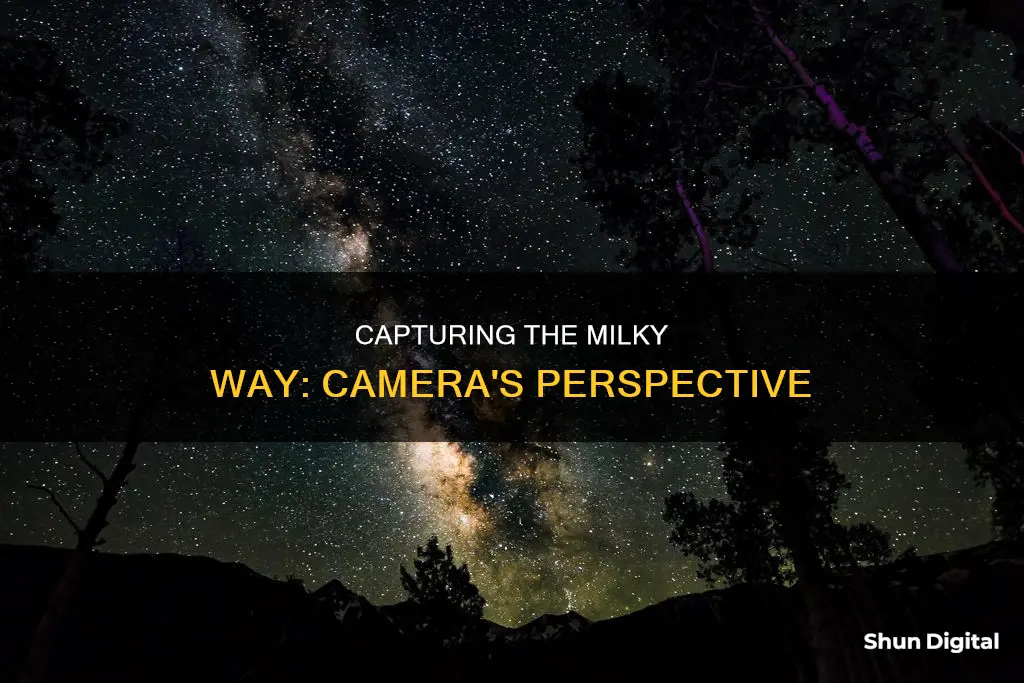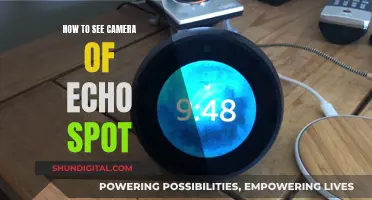
Capturing the Milky Way with a camera is a challenging yet rewarding task. The human eye is not as sensitive as a digital camera sensor, and it collects less light, resulting in a less detailed view of the Milky Way. Additionally, our eyes struggle to distinguish colours in low-light conditions, causing the Milky Way to appear as pale or milky patches rather than a colourful object in the night sky.
To photograph the Milky Way, it is recommended to use a DSLR or mirrorless camera with a lens in the 15-24mm range. Setting the camera to 'manual mode', using a moderately high ISO setting (ISO 1600 or higher), and the maximum aperture of the lens (f/4 or lower) will allow for a greater amount of starlight to reach the camera sensor. This will, in turn, reveal more structure and colour in the Milky Way than what can be seen with the naked eye.
The best time to photograph the Milky Way is during the summer months when there is less moonlight and clear skies. It is also important to find a location that is free from light pollution, as this can wash out the night sky and make it difficult to capture the Milky Way.
| Characteristics | Values |
|---|---|
| Camera type | DSLR or Mirrorless |
| Camera mode | Manual |
| Exposure time | 30 seconds |
| ISO | 1600 |
| Aperture | ƒ/4 or lower |
| Focal length | 15-24mm |
| Light pollution | Minimal |
| Time of year | April-September (Northern Hemisphere) |
What You'll Learn

Camera settings for capturing the Milky Way
To capture the Milky Way, you'll need a DSLR or mirrorless camera with manual mode and a lens in the 15-24mm range. Here are some key camera settings to help you get started:
- Shutter Speed: Use a long exposure of around 30 seconds. This will allow your camera to collect enough light to capture the Milky Way.
- Aperture: Use the widest aperture setting on your lens (f/4 or lower) to let in as much starlight as possible.
- ISO: Set your ISO to 1600 or higher to compensate for the dark conditions. You may need to adjust this setting depending on the amount of light pollution in your location.
- White Balance: Shooting in RAW format gives you more flexibility to adjust the white balance during post-processing.
- Focus: Use manual focus and set your lens to infinity. You can also use the Live View feature on your camera to zoom in and focus on a bright star.
- Tripod: Use a sturdy tripod to keep your camera stable during the long exposure.
- Location: Choose a dark location away from light pollution, preferably with a clear view of the southern sky.
Remember to scout your location during the day, compose your shot with interesting foreground elements, and take multiple images to stack and process later. With the right camera settings and some experimentation, you'll be well on your way to capturing stunning images of the Milky Way.
Spotting Active TV Cameras: What to Look For
You may want to see also

The Milky Way and light pollution
Light pollution is a pressing issue that has already deprived more than one-third of the world's population of the chance to see the Milky Way. This issue is only expected to worsen, with the continued increase in light pollution threatening to make our galaxy a distant memory for much of humanity.
The primary sources of light pollution are streetlamps, homes, and illuminations, which cast light into the sky, where it bounces off particles and moisture droplets in the atmosphere, creating artificial "sky glow". This obscures our view of the Milky Way and other celestial bodies.
The effects of light pollution are not limited to astronomy enthusiasts; it has biological consequences for birds, insects, mammals, and even humans, disrupting the natural behaviour of animals and raising human health concerns.
To address this issue, measures such as shielded street lighting, motion-activated lights, and cut-off times for illuminating buildings have been suggested. By implementing these strategies, we can not only reduce our electricity bills and carbon footprint but also reconnect with the awe-inspiring beauty of the night sky, inspiring curiosity and wonder.
To combat light pollution and capture the Milky Way, photographers must seek out dark sky locations, which are becoming increasingly rare. Even in these locations, the moon can interfere with light conditions, so it is best to shoot during the new moon phase or when the moon has set.
Additionally, photographers should utilise long-exposure images, typically ranging from 15 to 30 seconds, with a moderately high ISO setting of 1600 or higher, and the maximum aperture of their lens (f/4 or lower) to capture as much starlight as possible.
By employing these techniques and seeking out dark sky locations, photographers can increase their chances of capturing the Milky Way, despite the challenges posed by light pollution.
The Power of TV Cameras: Capturing Every Detail
You may want to see also

The best time of year to photograph the Milky Way
In the Northern Hemisphere, the best time to photograph the Milky Way is from March to September, while the Milky Way season goes from February to October. The best time of year to photograph the Milky Way in the UK is from mid-March to mid-May. However, the Milky Way can be visible for shorter periods of time throughout the UK Milky Way season, from late February to late September.
In the Southern Hemisphere, the best time of year to photograph the Milky Way is from late February to late October, while the Milky Way season goes from late January to late November.
The best time of day to photograph the Milky Way is usually between midnight and 5:00 on nights with a new moon during the Milky Way season.
Unlinking Your Camera from Your Smart TV
You may want to see also

The best locations for photographing the Milky Way
To find dark sky locations, you can use online resources such as:
- NASA's Blue Marble
- The World At Night (TWAN)
- International Dark Sky locations
- Wikipedia Observatories list
- Light Pollution Map
In addition, you can also refer to the Bortle scale, which measures the night sky's brightness of a particular location on a scale from 1 to 9, with 1 offering the best night sky conditions.
Some of the best locations for photographing the Milky Way include:
- Remote national parks and wilderness areas
- Dark Sky Finder website
- International Dark Sky locations
- The Canary Islands
- The Atacama Desert and the European Southern Observatory
- Arches National Park, Moab, UT
- The Dolomites, Italy
- Joshua Tree National Park, California
- The Alps
- The Grand Canyon, Arizona
- Death Valley, Alabama Hills
- Monument Valley
- The Lofoten Islands
- The Swiss and French Alps
Hidden Cameras: Are Your TV's Watching You?
You may want to see also

The limitations of the human eye when viewing the Milky Way
Firstly, the human eye is not as sensitive as a digital camera sensor, and we collect less light, resulting in a less detailed view of the Milky Way. The human eye struggles to resolve colour in low-light conditions, so instead of a colourful object in the night sky, the Milky Way appears as pale or milky patches.
To see the Milky Way with the naked eye, you need to be in a dark sky location, away from light pollution. Even then, the Milky Way will not be as bright or colourful as it appears in photographs. The human eye needs time to adjust to low-light conditions, and even then, the level of detail visible is far less than what a camera can capture.
Additionally, the location and timing of your observation play a crucial role. The core of the Milky Way, the brightest part, is visible from the Southern Hemisphere, and only partially visible from the Northern Hemisphere. The time of year also matters, with summer in the Northern Hemisphere being the best time to observe the galactic core.
The limitations of the human eye in viewing the Milky Way become more apparent when compared to long-exposure photographs. While a camera can collect light over an extended period, enhancing the visibility of the Milky Way, the human eye can only perceive a snapshot of the night sky, resulting in a less vibrant and detailed observation.
Building a Spy Camera: Transforming Your Smart TV
You may want to see also
Frequently asked questions
You can use a DSLR or mirrorless camera to see the Milky Way.
You should use a long-exposure image (about 30 seconds) with a moderately high ISO setting (ISO 1600+), and the maximum aperture of your lens (F/4 or lower).
In the Northern Hemisphere, the best time to see the Milky Way is from April to September, and in the Southern Hemisphere, it is from February to October.
The best time to see the Milky Way is usually between midnight and 5 a.m.







